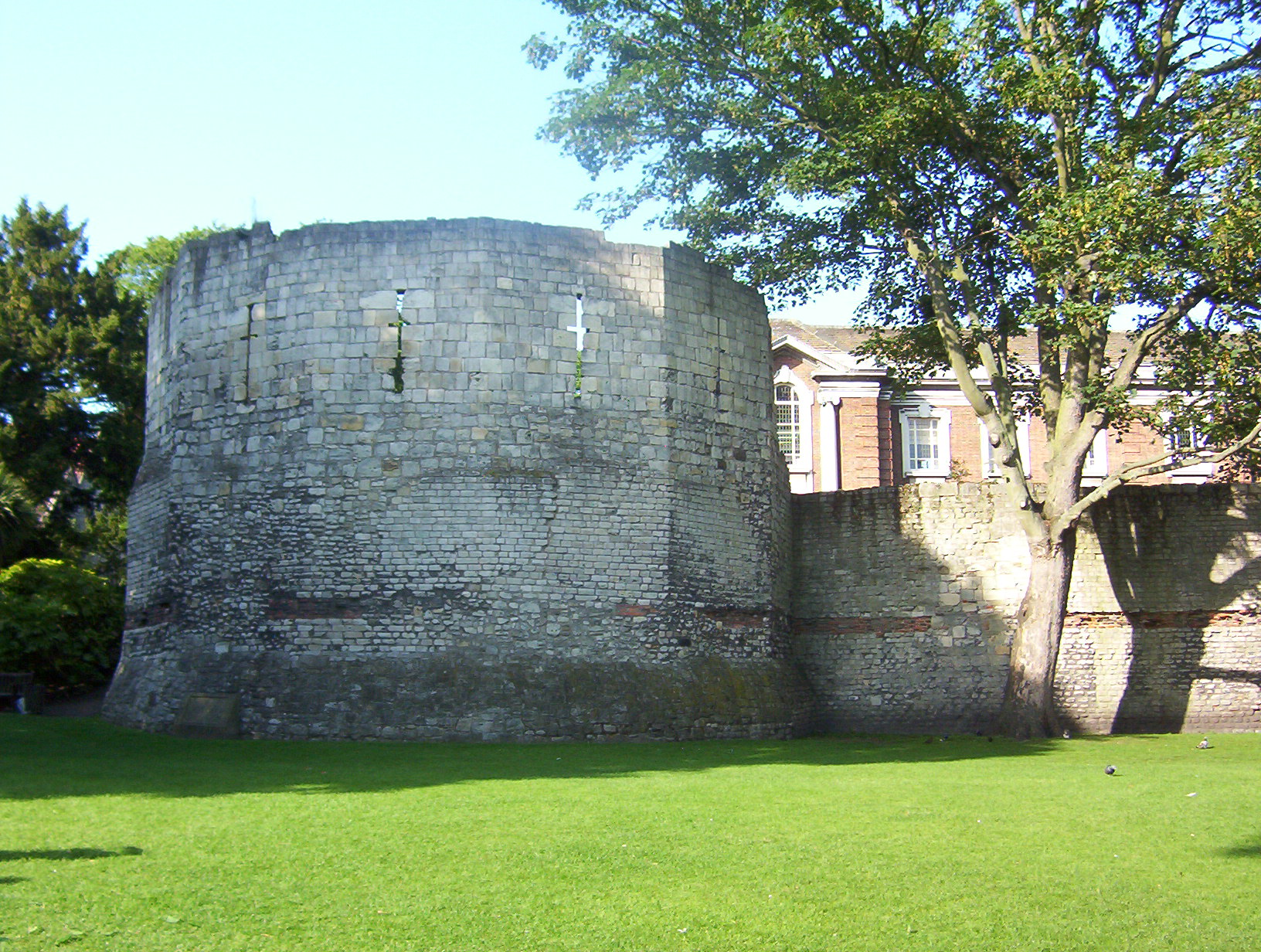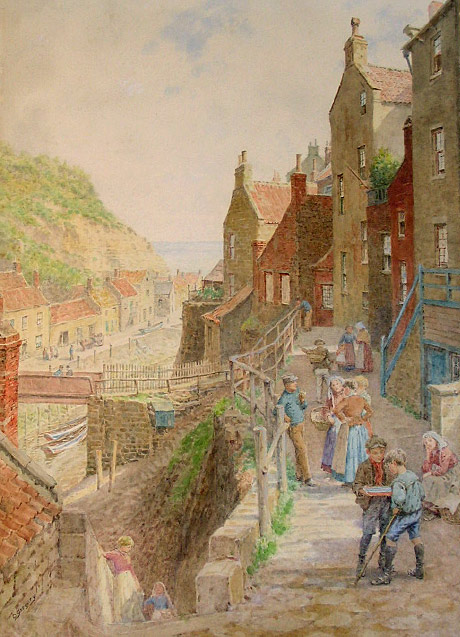|
Brockfield Hall
Brockfield Hall is a country house in Warthill, east of York in North Yorkshire, England. The hall was built in 1804 for Benjamin Agar, to a design by Peter Atkinson (architect, born 1735), Peter Atkinson. It is a two-storey building of brick, with a slate roof, and has three bays. It also has a lower two-storey service wing. On the main front, the central, entrance, bay comes further forward. It has a pilastered porch with a balcony above, and the entrance is arched, with double doors. There is a Venetian window to the balcony, while the other windows are all sashes. The central bay of the garden front is bowed, and a single-storey garden room has been added to the left. Inside the house, the entrance hall is circular, with a cast iron staircase rising through it. There is a decorative cornice and frieze, which may be slightly later than 1804. The drawing room and morning room also have early decoration. The house was Grade II listed in 1953, and raised to Grade II* listed ... [...More Info...] [...Related Items...] OR: [Wikipedia] [Google] [Baidu] |
Country House
An English country house is a large house or mansion in the English countryside. Such houses were often owned by individuals who also owned a Townhouse (Great Britain), town house. This allowed them to spend time in the country and in the city—hence, for these people, the term distinguished between town and country. However, the term also encompasses houses that were, and often still are, the full-time residence for the landed gentry who ruled rural Britain until the Reform Act 1832. Frequently, the formal business of the Historic counties of England, counties was transacted in these country houses, having functional antecedents in manor houses. With large numbers of indoor and outdoor staff, country houses were important as places of employment for many rural communities. In turn, until the Great Depression of British Agriculture, agricultural depressions of the 1870s, the estates, of which country houses were the hub, provided their owners with incomes. However, the late 1 ... [...More Info...] [...Related Items...] OR: [Wikipedia] [Google] [Baidu] |
Warthill
Warthill is a village and civil parish in the Ryedale district of North Yorkshire, England, six miles north-east of York and 14 miles south-west of Malton. The village has one public house, ''The Agar Arms'', and a Church of England primary school (established in 1863), with about forty pupils. Warthill is home to St Mary's Church, which was built in the 19th century and is a good example of Victorian Gothic architecture. Brockfield Hall, a Georgian house completed in 1807, is situated nearby. It was built for Benjamin Agar by Peter Atkinson senior who worked in the office of John Carr (architect). Brockfield has an oval entry hall with cantilevered staircase. The house displays fine art and furniture, and mementos associated with the Fitzalan Howard family. There is also an unusual collection of glass walking sticks. The house is rectangular in plan, with a hipped slate roof. The most immediately noticeable feature is a large Venetian window on the first floor which is ... [...More Info...] [...Related Items...] OR: [Wikipedia] [Google] [Baidu] |
York
York is a cathedral city with Roman Britain, Roman origins, sited at the confluence of the rivers River Ouse, Yorkshire, Ouse and River Foss, Foss in North Yorkshire, England. It is the historic county town of Yorkshire. The city has many historic buildings and other structures, such as a York Minster, minster, York Castle, castle, and York city walls, city walls. It is the largest settlement and the administrative centre of the wider City of York district. The city was founded under the name of Eboracum in 71 AD. It then became the capital of the Roman province of Britannia Inferior, and later of the kingdoms of Deira, Northumbria, and Jórvík, Scandinavian York. In the Middle Ages, it became the Province of York, northern England ecclesiastical province's centre, and grew as a wool-trading centre. In the 19th century, it became a major railway network hub and confectionery manufacturing centre. During the Second World War, part of the Baedeker Blitz bombed the city; it ... [...More Info...] [...Related Items...] OR: [Wikipedia] [Google] [Baidu] |
North Yorkshire
North Yorkshire is the largest ceremonial county (lieutenancy area) in England, covering an area of . Around 40% of the county is covered by national parks, including most of the Yorkshire Dales and the North York Moors. It is one of four counties in England to hold the name Yorkshire; the three other counties are the East Riding of Yorkshire, South Yorkshire and West Yorkshire. North Yorkshire may also refer to a non-metropolitan county, which covers most of the ceremonial county's area () and population (a mid-2016 estimate by the ONS of 602,300), and is administered by North Yorkshire County Council. The non-metropolitan county does not include four areas of the ceremonial county: the City of York, Middlesbrough, Redcar and Cleveland and the southern part of the Borough of Stockton-on-Tees, which are all administered by unitary authorities. The non-metropolitan county and the City of York are within the Yorkshire and the Humber region. Middlesbrough, Redcar ... [...More Info...] [...Related Items...] OR: [Wikipedia] [Google] [Baidu] |
Peter Atkinson (architect, Born 1735)
Peter Atkinson (1735–1805) was an English architect. Biography He was born at or near Ripon and started work as a carpenter. He later became an assistant to John Carr and was employed at Buxton, Harewood and elsewhere. In 1786 he became responsible for maintaining York's corporation property, and subsequently took over Carr's extensive works in Yorkshire and further north. The Atkinson family of York architects continued after Atkinson's death. His son, Peter, himself had sons John Bownas Atkinson (1807–1874) and William Atkinson (architect, born 1811). Before their father's death, the two sons had taken over and for the next thirty plus years they were the most prolific of the city's architects. In 1877 William took James Demaisne (1842–1911) as partner. Works Among Atkinson's works were: * No. 18 Blake Street, York, c. 1789 * Monk Bridge, York, 1794 (later widened in 1924–26) * Hackness Hall, 1797, a large mansion for Sir R.V.B. Johnstone at Hackness (near Scarbo ... [...More Info...] [...Related Items...] OR: [Wikipedia] [Google] [Baidu] |
Venetian Window
A Venetian window (also known as a Serlian window) is a large tripartite window which is a key element in Palladian architecture. Although Sebastiano Serlio (1475–1554) did not invent it, the window features largely in the work of the Italian architect Andrea Palladio (1508–1580) and is almost a trademark of his early career. The true Palladian window is an elaborated version. Overview The Venetian window consists of an arched central light, symmetrically flanked by two shorter sidelights. Each sidelight is flanked by two columns or pilasters and topped by a small entablature. The entablatures serve as imposts supporting the semicircular arch that tops the central light. In the library at Venice, Sansovino varied the design by substituting columns for the two inner pilasters. To describe its origin as being either Palladian or Venetian is not accurate; the motif was first used by Donato Bramante and later mentioned by Serlio in his seven-volume architectural book ' ... [...More Info...] [...Related Items...] OR: [Wikipedia] [Google] [Baidu] |
Grade II* Listed
In the United Kingdom, a listed building or listed structure is one that has been placed on one of the four statutory lists maintained by Historic England in England, Historic Environment Scotland in Scotland, in Wales, and the Northern Ireland Environment Agency in Northern Ireland. The term has also been used in the Republic of Ireland, where buildings are protected under the Planning and Development Act 2000. The statutory term in Ireland is " protected structure". A listed building may not be demolished, extended, or altered without special permission from the local planning authority, which typically consults the relevant central government agency, particularly for significant alterations to the more notable listed buildings. In England and Wales, a national amenity society must be notified of any work to a listed building which involves any element of demolition. Exemption from secular listed building control is provided for some buildings in current use for wor ... [...More Info...] [...Related Items...] OR: [Wikipedia] [Google] [Baidu] |
Staithes Group
The Staithes group or Staithes School was an art colony of 19th-century painters based in the North Yorkshire fishing village of Staithes. Inspired by French Impressionists such as Monet, Cézanne and Renoir, the group of about 25 artists worked together in plein air, in oil or watercolour. The group contained renowned artists such as Laura Knight (who kept a studio in the village with her husband and fellow painter Harold Knight), Frederick W. Jackson, Edward E. Anderson, Joseph R. Bagshawe, Thomas Barrett and James W. Booth. Member artists *Edward Enoch Anderson (1878–1961) *John Atkinson (1863–1924) * Joseph R. Bagshawe (1870–1909) *Thomas Barrett (1848–1924) *James William Booth (1867–1953) *Owen Bowen (1873–1967) *John Bowman (1872–1915) *Andrew Charles Colley (1859–1910) *Harold Edward Conway (b.1872) *Lionel Townsend Crawshaw (1864–1949) * Ernest Dade (1868–1936) *William Gilbert Foster (1855–1906) *Arthur A Friedenson (1872–1955) *Sidney Val ... [...More Info...] [...Related Items...] OR: [Wikipedia] [Google] [Baidu] |
Country Houses In North Yorkshire
A country is a distinct part of the world, such as a state, nation, or other political entity. It may be a sovereign state or make up one part of a larger state. For example, the country of Japan is an independent, sovereign state, while the country of Wales is a component of a multi-part sovereign state, the United Kingdom. A country may be a historically sovereign area (such as Korea), a currently sovereign territory with a unified government (such as Senegal), or a non-sovereign geographic region associated with certain distinct political, ethnic, or cultural characteristics (such as the Basque Country). The definition and usage of the word "country" is flexible and has changed over time. ''The Economist'' wrote in 2010 that "any attempt to find a clear definition of a country soon runs into a thicket of exceptions and anomalies." Most sovereign states, but not all countries, are members of the United Nations. The largest country by area is Russia, while the smallest i ... [...More Info...] [...Related Items...] OR: [Wikipedia] [Google] [Baidu] |
Historic House Museums In North Yorkshire
History (derived ) is the systematic study and the documentation of the human activity. The time period of event before the invention of writing systems is considered prehistory. "History" is an umbrella term comprising past events as well as the memory, discovery, collection, organization, presentation, and interpretation of these events. Historians seek knowledge of the past using historical sources such as written documents, oral accounts, art and material artifacts, and ecological markers. History is not complete and still has debatable mysteries. History is also an academic discipline which uses narrative to describe, examine, question, and analyze past events, and investigate their patterns of cause and effect. Historians often debate which narrative best explains an event, as well as the significance of different causes and effects. Historians also debate the nature of history as an end in itself, as well as its usefulness to give perspective on the problems of the p ... [...More Info...] [...Related Items...] OR: [Wikipedia] [Google] [Baidu] |
Houses Completed In 1804
A house is a single-unit residential building. It may range in complexity from a rudimentary hut to a complex structure of wood, masonry, concrete or other material, outfitted with plumbing, electrical, and heating, ventilation, and air conditioning systems.Schoenauer, Norbert (2000). ''6,000 Years of Housing'' (rev. ed.) (New York: W.W. Norton & Company). Houses use a range of different roofing systems to keep precipitation such as rain from getting into the dwelling space. Houses may have doors or locks to secure the dwelling space and protect its inhabitants and contents from burglars or other trespassers. Most conventional modern houses in Western cultures will contain one or more bedrooms and bathrooms, a kitchen or cooking area, and a living room. A house may have a separate dining room, or the eating area may be integrated into another room. Some large houses in North America have a recreation room. In traditional agriculture-oriented societies, domestic animals su ... [...More Info...] [...Related Items...] OR: [Wikipedia] [Google] [Baidu] |
.jpg)





.jpg)
